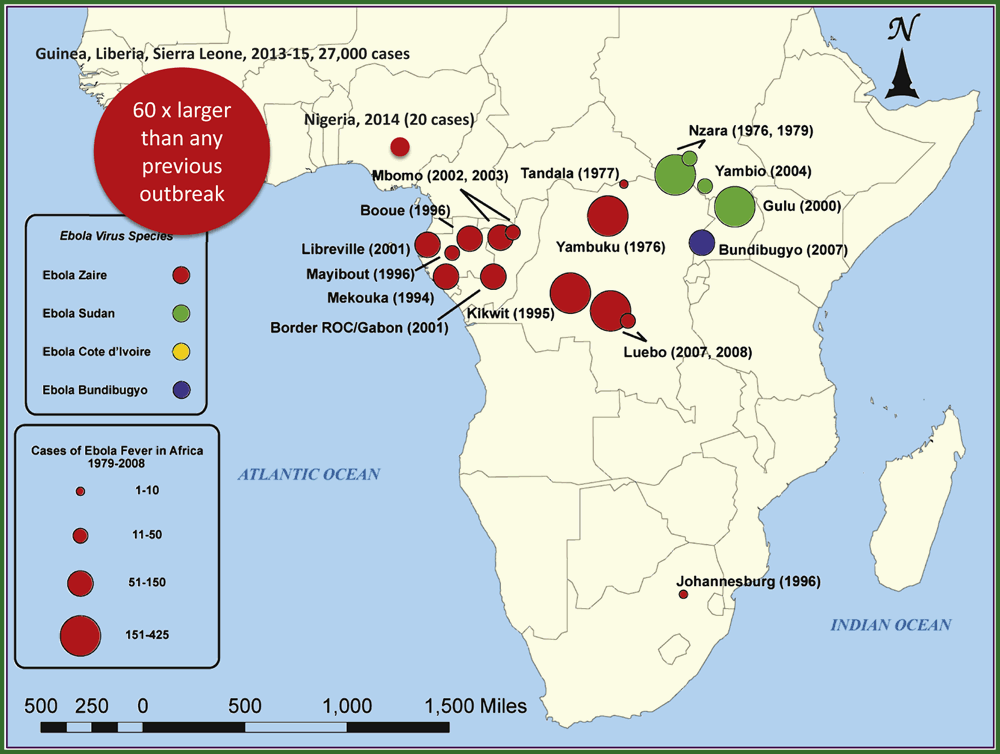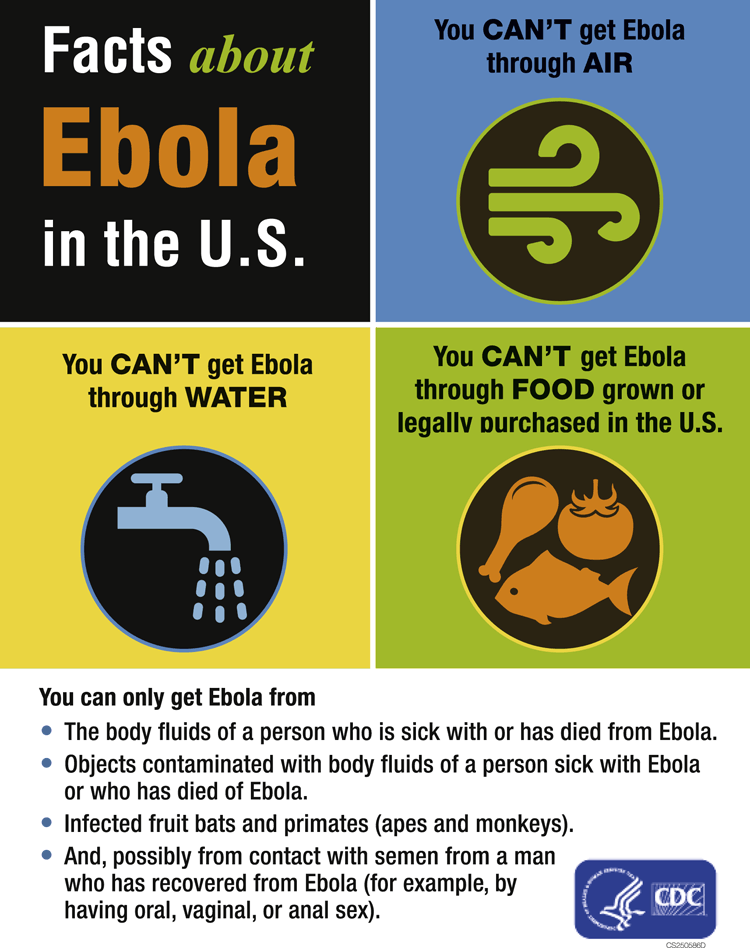Out of Africa: response to Ebola in the developed world; lessons for the future
Lyn Gilbert A and Peter Collignon BA Centre for Infectious Diseases and Microbiology
Westmead Hospital and University of Sydney
Email: lyn.gilbert@sydney.edu.au
B ACT Pathology
Canberra Hospital
Garran, ACT, Australia
Email: peter.collignon@act.gov.au
Microbiology Australia 36(3) 144-147 https://doi.org/10.1071/MA15053
Published: 28 August 2015
The unprecedented, ongoing Ebola virus disease (‘Ebola’) outbreak in West Africa has caused nearly 28 000 cases and more than 11 000 deaths between December 2013 and July 20151, including 876 cases and 509 deaths among healthcare workers (HCW). It is over 60 times larger than any of 26 previous outbreaks, since 1976 when Ebola was first recognised, the largest of which involved ~450 cases (Figure 1). It is the first to have occurred in West Africa and spread across national borders, to major cities and beyond Africa.
It came to attention in March 2014, when the Guinean Ministry of Health notified WHO of a ‘mysterious disease’ that had been occurring in Guéckédou province, since December. Although it had not previously occurred in the region, Ebola was confirmed a week later2. By the end of March, cases were reported in neighbouring Liberia and, later, Sierra Leone3.
Despite warnings from Médicins sans Frontières (MSF), in June 2014, that the outbreak was out of control4 and increasingly urgent calls for international help, there was little response until August, when two American aid-workers were evacuated to USA from Liberia, with Ebola. A week later (8 August), WHO belatedly acknowledged that the outbreak was ‘a public health emergency of international concern’5. In early September, when the grossly inadequate local health workforce had been further depleted by HCW deaths and patients were being turned away from overcrowded hospitals, an increasingly frustrated MSF President denounced the ‘dangerously inadequate’ international response as a ‘coalition of inaction’6 and challenged the West to provide people rather than financial promises. Within two weeks, the US president announced deployment of 3000 military personnel to build treatment centres and train HCWs7. On 18 September the UN Security Council declared the outbreak ‘a threat to international peace and security’ and established the Mission for Ebola Emergency Response (UNMEER), with powers similar to that of a peacekeeping mission – the first of its kind for a health emergency8.
Meanwhile, the American aid-workers had recovered after several weeks’ treatment in the high security containment facility at the Emory University Hospital, which had been built by the Centers for Disease Control (CDC) to care for returning aid-workers with highly transmissible diseases. The CDC had reassured Americans that there was minimal public risk (Figure 2)9,10, since Ebola spreads only by contact with blood or body fluids of patients in the ‘wet’ stage of the disease – not by the respiratory route – and hospital spread could be prevented by strict droplet and contact precautions.
This reassurance was first challenged when a nurse became ill, after caring for a Spanish priest, who had died from Ebola in Madrid after being evacuated from West Africa11. Then, a Liberian-American man, who had recently returned from Liberia, was admitted to hospital in Dallas, Texas, seriously ill with abdominal pain and diarrhoea; Ebola was diagnosed two days later. When two nurses who had cared for him became ill with Ebola there was a storm of recrimination and fear in America12. The CDC Director, Tom Frieden, suggested, reasonably, that the nurses’ infections had resulted from breaches of infection control (IC) protocol13,14; this infuriated the nurses’ union, who claimed the hospital had no protocols15. Frieden apologised for apparently blaming the nurses, but pointed out that all hospitals should have appropriate transmission-based IC protocols16.
Nevertheless, CDC changed their IC guidelines and recommended personal protective equipment (PPE) to include respiratory route protection by using P2/N95 mask or powered air-purifying respirator (PAPR), rather than just a water-repellent surgical mask. They also recommended complete coverage of all mucous membranes, skin and hair and scrupulous care with removal17. It was not clear exactly how the nurses became infected, but hasty removal of PPE carries a high risk of skin and/or mucous membrane contamination. CDC recommended intensive and repeated training of staff, short shifts (to prevent excessive sweating and fatigue) and supervision by a ‘buddy’, to provide reassurance, check integrity of PPE and ensure its removal in correct sequence18.
In the circumstances, these recommendations were reasonable for care of patients with ‘wet’ Ebola and were reflected in the IC guidelines of most western countries, including Australia. However, there was controversy about what PPE should be used for initial management of people who had recently been in an affected country, possibly had contact with Ebola, had ‘dry’ symptoms, such as fever, headache, malaise but not vomiting, diarrhoea or bleeding and were awaiting test results. In Australia19 and elsewhere, some authorities, evoking the precautionary principle, advocated full PPE, as for care of a ‘wet’ case; they feared that the high toll among African HCWs indicated increased virulence and/or transmissibility of Ebola virus and cited unconfirmed reports of possible respiratory transmission. Others strongly advocated ‘routine’ contact and droplet precautions because (a) PPE was widely available and HCWs were familiar with its use; (b) there were other explanations for high HCW infection rates in Africa and no evidence of increased transmissibility or virulence; and (c) the diagnosis was far more likely to be a common traveller’s infection, such as malaria, and excessive caution could delay appropriate diagnosis and management20. In general, the latter, moderate view prevailed.
There was further controversy, when a MSF volunteer, developed Ebola 6 days after returning to New York from Guinea. According to protocol he had taken his temperature twice daily and immediately reported to hospital when it rose. Although quarantine was not required while he remained well – asymptomatic people do not spread Ebola virus – some media and politicians accused him of recklessly endangering public safety21. The New York and New Jersey governors announced that, in future, anyone returning from an Ebola-affected country, after possible contact, would be quarantined for the 21-day incubation period22. After a volunteer nurse was summarily quarantined in New Jersey, MSF objected strongly because, like CDC and the White House, they pointed out that it was unnecessary and would discourage HCWs from volunteering23.
Meanwhile, the tide had begun to turn in Africa, due to the co-ordinated efforts of UNMEER, local and foreign government agencies and NGOs which had established treatment units, community care centres and laboratories and trained many more foreign and local HCWs, contact tracers and safe burial teams24. On 9 May 2015, Liberia was declared Ebola-free but, at the time of writing (July 2015), cases are still occurring – albeit in much reduced numbers – in Sierra Leone and Guinea and six new cases have occurred in Liberia1. The threat is not over, but the turnaround confirms past experience, that Ebola outbreaks can be controlled relatively quickly, once the necessary ‘staff, stuff, space and systems’25 are available. A rapid response to MSF’s warnings and pleas for help, in June 2014, could have prevented much of what followed. Criticism of WHO for its slow response was justified and has been acknowledged by the Director-General26; but WHO was not – and still is not – adequately resourced to respond, rapidly, to infectious disease emergencies27. A concerted international effort will be needed to establish a global emergency response workforce28 and build resilient health systems in developing countries, including hospitals with adequate supplies of PPE and appropriately trained healthcare workers.
The threat to HCWs in developed countries from imported Ebola and the high mortality among African HCWs focussed attention on hospital IC like nothing before. Many hospitals spent a fortune preparing facilities and staff for a possible Ebola case, often in the context of previously dwindling IC budgets and poor staff compliance with IC practices29. Has this experience, taught us how to stop the next infectious disease emergency at its source and avoid the desperate scramble, elsewhere, to train and equip hospital staff for what should be ‘business as usual’? Without strong political and professional leadership there is a risk that, once the crisis passes, lessons will be forgotten, funds redeployed and bad habits reinstated30.
References
[1] World Health Organization. (2015) Ebola situation report – 15 July 2015. http://apps.who.int/ebola/current-situation/ebola-situation-report-15-july-2015[2] World Health Organization. (2015) Ground zero in Guinea: the outbreak smoulders – undetected – for more than 3 months. A retrospective on the first cases of the outbreak. http://www.who.int/csr/disease/ebola/ebola-6-months/guinea/en/
[3] WHO Ebola Response Team (2014) Ebola virus disease in West Africa – the first 9 months of the epidemic and forward projections. N. Engl. J. Med. 371, 1481–1495.
| Ebola virus disease in West Africa – the first 9 months of the epidemic and forward projections.Crossref | GoogleScholarGoogle Scholar | 25244186PubMed |
[4] Médicins sans Frontières. (2014) ‘The epidemic is out of control.’ 23 June 2014. http://www.msf.ca/en/article/ebola-west-africa-epidemic-out-control
[5] World Health Organization. (2014) Statement on the 1st meeting of the IHR Emergency Committee on the 2014 Ebola outbreak in West Africa. 8 August 2014. http://www.who.int/mediacentre/news/statements/2014/ebola-20140808/en/
[6] Médicins sans Frontières. (2014) Global bio-disaster response urgently needed in Ebola fight. 2 September 2014. http://www.msf.org/article/global-bio-disaster-response-urgently-needed-ebola-fight
[7] Cooper, H. et al. (2014) U.S. to commit up to 3,000 troops to fight Ebola in Africa. New York Times 15 September 2014. http://www.nytimes.com/2014/09/16/world/africa/obama-to-announce-expanded-effort-against-ebola.html
[8] UN News Centre. (2014) UN announces mission to combat Ebola, declares outbreak ‘threat to peace and security’. 18 September 2014. http://www.un.org/apps/news/story.asp?NewsID=48746#.Va3PO7c0H-Y
[9] Centers for Disease Control. Facts about Ebola in the US. http://www.cdc.gov/vhf/ebola/pdf/infographic.pdf
[10] Centers for Disease Control Guidelines for Evaluation of US Patients Suspected of Having Ebola Virus Disease. (2014) 1 August 2014. https://www.dallascounty.org/department/hhs/documents/CDCEbolaHealthAdvisory08-01-2014_000.pdf
[11] World Health Organization. Spanish nurse diagnosed with Ebola virus disease. http://www.euro.who.int/en/health-topics/emergencies/pages/news/news/2014/10/spanish-nurse-diagnosed-with-ebola-virus-disease
[12] Burrough, B. (2015) Trial by Ebola. Vanity Fair February. Available at: http://www.vanityfair.com/news/2015/02/ebola-us-dallasepidemic (accessed 24 February 2015).
[13] Centers for Disease Control. (2014) CDC update on Dallas Ebola Response, 10-12-2014. http://www.cdc.gov/media/releases/2014/t1012-ebola-reponse-update.html
[14] http://www.cbsnews.com/news/cdc-chief-on-second-ebola-case-there-was-a-breach-in-protocol/
[15] http://www.cbsnews.com/news/nurses-union-dallas-hospital-lacked-ebola-protocols/
[16] http://www.pbs.org/newshour/rundown/cdc-hold-news-conference-ebola-response-u-s/
[17] http://www.cdc.gov/media/releases/2014/fs1020-ebola-personal-protective-equipment.html
[18] Centers for Disease Control and Prevention. (2014) Guidance on personal protective equipment to be used by healthcare workers during management of patients with Ebola virus disease in US hospitals, including procedures for putting on (donning) and removing (doffing). Atlanta, GA: CDC.
[19] Department of Health Australia. (2015) Infection prevention and control principles and recommendations for Ebola virus disease. http://www.health.gov.au/internet/main/publishing.nsf/Content/D9CE7F7977BFB6A8CA257D8D00834F53/$File/ebola-infections-prevention-final-Mar2015.pdf
[20] Gilbert, GL and Kerridge, I (2015) Communication and communicable disease control: lessons from Ebola virus disease. Amer. J. Bioethics 15, 62–65.
| Communication and communicable disease control: lessons from Ebola virus disease.Crossref | GoogleScholarGoogle Scholar |
[21] Spencer, C. (2015) Having and fighting Ebola — public health lessons from a clinician turned patient. N. Engl. J. Med. 372, 1089–1091.
| Having and fighting Ebola — public health lessons from a clinician turned patient.Crossref | GoogleScholarGoogle Scholar | 1:CAS:528:DC%2BC2MXhtVOgs73J&md5=b2dd27112800a744f6970900fe03f630CAS | 25714039PubMed |
[22] http://www.usatoday.com/story/news/2015/02/25/craig-spencer-ebola-doctor/24004889/
[23] Medicins sans Frontiere. MSF nurse held in isolation in New Jersey. http://www.doctorswithoutborders.org/article/msf-nurse-held-isolation-new-jersey
[24] United Nations. (2015) Global Ebola response. Making a difference – progress report 2015. https://ebolaresponse.un.org/progress-2015
[25] Farmer, P. (2014) London Review of Books. Diary 23 October 2014. http://www.lrb.co.uk/v36/n20/paul-farmer/diary
[26] WHO Director-General’s speech at the sixty-eight World Health Assembly. http://www.who.int/dg/speeches/2015/68th-wha/en/
[27] Wilkinson, A., and Leach, M. (2015) Briefing: Ebola—Myths, realities and structural violence. African Affairs 114/454, 136–148.
| Briefing: Ebola—Myths, realities and structural violence.Crossref | GoogleScholarGoogle Scholar |
[28] Gates, B. (2015) The next epidemic – lessons from Ebola. N. Engl. J. Med. 372, 1381–1384.
| The next epidemic – lessons from Ebola.Crossref | GoogleScholarGoogle Scholar | 1:CAS:528:DC%2BC2MXns1Wrsb8%3D&md5=a894b1f512d82528709a260f07de1485CAS | 25853741PubMed |
[29] Drazen, J. M. et al. (2015) Ebola in West Africa at one year—From ignorance to fear to road blocks. N. Engl. J. Med. 372, 563–564.
| Ebola in West Africa at one year—From ignorance to fear to road blocks.Crossref | GoogleScholarGoogle Scholar | 1:CAS:528:DC%2BC2MXhtVOjtb7O&md5=9355c8da1b12027f9c9330dc278ffc7bCAS | 25539445PubMed |
[30] Gostin, L.O. et al. (2015) The President’s national security agenda: curtailing Ebola, safeguarding the future. JAMA 313, 27–28.
| The President’s national security agenda: curtailing Ebola, safeguarding the future.Crossref | GoogleScholarGoogle Scholar | 1:CAS:528:DC%2BC2MXit1Ons7s%3D&md5=33043c4bed3ac39c45e06bf03111580bCAS | 25412348PubMed |




